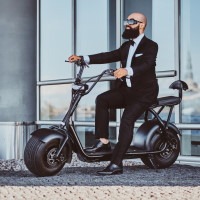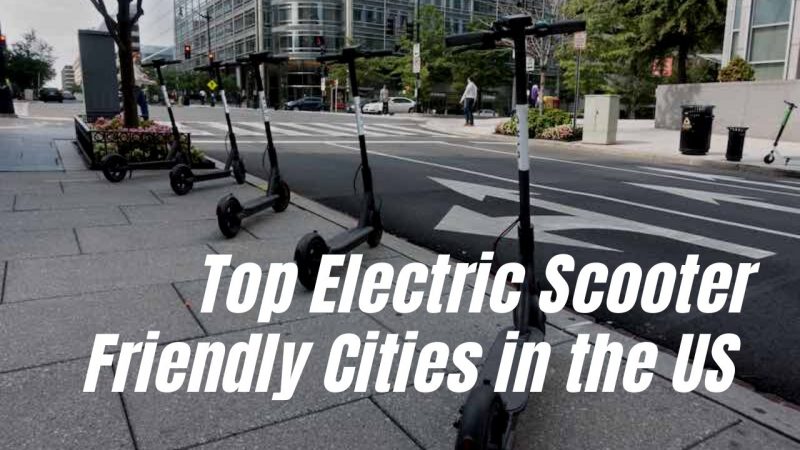This page contains affiliate links. This means that we may get a small commission for recommending products, if you choose to click on something and buy it. This does not cost you anything, but we wanted to be honest and let you know!
(Last Updated On: )Table of Contents
Shared Electric Scooters
As of November 2019, over 100 cities in the United States can be considered electric scooter friendly cities because they had e-scooters in their major city centers.
Users took over 38.5 million trips on them, according to the National Association of City Transportation Officials.
That is more than double from the number in 2017 when the e-scooter first appeared on city streets, as if by magic.
According to a 2019 article in USA Today, electric scooters add a buzz to city sightseeing.
How it works
Similar to bike and car shares, e-scooters are an emerging technology and mobility service. The service provides a shared vehicle in the form of a small electric powered scooter available to rent for one-way trips.
The existing technology, the scooters themselves, are paired with an app-based technology that allows a user to rent the vehicle for a short term using a credit card.
Relatively easy to ride, and after initial kick-off, the scooters are powered by an electric motor.
Users unlock a scooter through the company’s smartphone app. Once the user downloads the app, they pay (at this writing) $1 plus 15 cents a minute to ride them.
When ending a trip, the user parks the scooter on a sidewalk out of the pedestrian way, with some companies requiring a picture of the scooter’s location.
Most U.S. cities have, if not welcomed, at least allowed the use of e-scooters, but the introduction of this mode of transportation has not been easy.
You can easily purchase an e-scooter in New York. Still, it has been illegal to ride an e-scooter on New York streets, although the city is full of people zipping around on them.
The State of New York passed a bill in June of 2019 to legalize them, but you will have to own an e-scooter to ride one in Manhattan.
E-scooters: Where is it legal and illegal to ride?
There have been some cities that have said no to the mobility devices, such as Chattanooga, Tennessee, that banned the vehicles for six months in 2019.
Nashville‘s mayor called for a ban but later decided to reduce the number of scooters allowed instead.
There have been conflicting attitudes towards the scooters, and even the cities that allow them can have regulations that are often unclear to users.
One of the reasons that the attitude towards e-scooters has been ambivalent is related, in some cases, to how the scooters were introduced.
Bird, one of the company operators of e-scooters, would simply plop hundreds of scooters in a city center with no introduction. (Santa Monica, San Francisco, San Diego, Nashville, and Milwaukee)
The cities, rightly so, were perturbed by the “beg for forgiveness rather than ask permission” attitude.
It left leaders in charge of public safety with the dilemma of how to regulate the devices, a challenge that was dropped in their lap without notice.
Even the companies themselves had no permits to operate in city centers. City regulators loathe electric scooters.
With a rough and unpleasant beginning, leaders scrambled to address the new technology, all while fielding complaints from the general public.
The less than stellar behavior of those scooter riders who embraced the mobility devices before cities knew what to do with them didn’t help either.
Even with a “ready or not” start, e-scooters are more likely than not to be here to stay. The number of trips taken on scooters more than doubled in two years, tremendous growth in a short length of time.
The users themselves will not want to go back to former modes of transportation. Now that users have had the opportunity to experience all that scooters have to offer, it would be difficult to go to the daily slog.
There may have been a method to the madness when e-scooters were introduced in the guerrilla fashion that they were.
Electric Scooter Friendly Cities
With all of the controversy, just where will you find an electric scooter friendly city? We have compiled a list below.
With over 100 cities in the U.S. now inundated with scooters, we have looked at a few who have ended up welcoming the scooters and one that has said: “not so much,”
Arlington, Virginia
The County Board adopted regulations for “micro-mobility devices” that allow their use on trails, bike lanes, and sidewalks (with limitations) on November 16, 2019.
In this case, micro-mobility devices include pedal bicycles, motorized skateboards, e-scooters, and electric power-assisted bicycles.
This ordinance went into effect on December 31st, 2019. According to Arlington County Board Chair Christian Dorsey, “Arlington is all about transportation options.
Based on the evidence gathered during our pilot program, scooters and other micro-mobility devices are a viable transportation alternative for many.”
Most of these transportation devices do not have docking stations, so the County also has a series of corrals to encourage proper parking.
A great way to explore a city, Paul DeMaio, who manages the bike and scooter share programs in Arlington, says that “It can be a lot of fun. It’s surprising how quickly they have caught on and spread”.
The Board voted unanimously to approve the regulations and to permit the process.
The city also established a procedure for anyone who wanted to report an issue, such as an e-scooter being left on private property.
Their website has a list of phone numbers and email addresses for each operator that has a permit with the city. The operators have agreed to resolve issues within two hours.
If not, the city has an email established for people to notify them if there has not been a resolution on time.
Operators in Arlington at this printing are Bird, JUMP, Lime, Lyft, Razor, Skip, and Spin.
Santa Monica, California
In 2016, residents in Santa Monica rated traffic and congestion as one of their top main concerns. Although a new Metro Expo Line had opened, it was still challenging to get around.
While Santa Monica was one of the first cities to regulate scooters and dockless bikes, the road to this distinction was not without its speed bumps.
Back in February of 2018, black, electric-powered scooters mysteriously began appearing on streets downtown.
The appearance of these scooters in 2017 took the city, and the mayor, by surprise. It was not until after these Bird scooters had landed that the mayor received a Linkedin message from the chief executive of Bird offering to introduce the new mobility strategy to Santa Monica.
After some fits and starts, Santa Monica addressed the issue of the unexpected landing of Bird scooters. She came up with a plan to incorporate this mode of transportation.
The scooters have been a popular way of getting around, and by September of 2018, more than 40,000 people had taken a ride on one of the Bird scooters.
Santa Monica has created special slow zones on the city boardwalk and added painted-off corrals to park vehicles.
Their website, santamonica.com, gives rider guidelines to make the experience more comfortable and user-friendly for all.
The police department has used a bit of comedy to spread the expectations of riders in this YouTube video. SMPD Electric Scooter rules
The city chose four companies, Lime, Bird, Lyft, and Jump, to provide scooters to Santa Monica. “The selected companies bring a wide range of local, national, and international experience that will contribute to a comprehensive and informative pilot program,” city Planning Director David Martin said.
Austin, Texas
After the Bird scooters had descended in-flock on Santa Monica, Austin city officials began seeking feedback on dockless bikes and scooters to get a jump on any flocks that might want to nest in their city.
As with most of the cities that struggle with transportation issues, Austin also experienced companies who dropped off scooters before rules and regulations were in place.
It was a delicate balance between getting permits and guidelines rolled out, and losing operators who might not want to wait but move on to other cities.
Early April in 2018 was when the scooters appeared in downtown Austin. According to records from that year, from September 5 through November 30, 2018, a total of 936,110 e-scooter trips were taken.
This translated to 182,333 hours of e-scooter use and 891,121 miles ridden on e-scooters.
Austin now has ten licensed scooters operators in the city, and each operator is allowed 500 vehicles in the downtown Austin area. Among those operators are Bird, Lime, Jump, Lyft, and Spin.
The scooters are a favorite with convention-goers who seem to love them. They make getting around downtown for events and parties a breeze (literally).
It makes for a brief ride that can cost as little as fifty cents and save all kinds of time and hassle.
The Austin area has also approved another type of electric scooter for commuting city streets, the OjO (pronounced oh Joe). Austin will be the first launch market for the company’s new scooters.
These scooters are sit down (or stand) models, with navigation, traffic alerts, geo-fence approaches, and docking locations alerts that are all run through an onboard speaker. The rider will also be able to play music through Bluetooth.
Portland, Oregon
When the e-scooter arrived in 2017 as a mobility device, Portland took a proactive road and created an e-scooter pilot program.
The Portland Bureau of Transportation (PBOT) understood that this form of transportation was on its way, and wanted to ensure that its citizens had access to the device. They also wanted to ensure that the scooters would be in alignment with policy values.
The pilot program sought to determine whether, and how, scooters could help meet Portland transportation needs.
During a 120 day pilot period, the company operators were required to provide specific data to PBOT, which was supplemented with rider surveys, focus groups, and a citywide poll.
Portland found that residents and visitors embraced e-scooters. During that four-month tracking time frame, over 700,369 trips that covered 801,887 miles were taken on 2,043 scooters.
With over 62% of residents favoring the new mobility addition, the PBOT started another pilot program in April 0f 2019 and will run until April 2020. This program will seek measures to improve public safety and protect City parks.
The previous program showed that e-scooters have the potential to reduce both congestion and pollution.
Once the results of the latest pilot program are in, PBOT will make recommendations for permanent rules for shared mobility devices that the City Council will consider for implementation.
Denver, Colorado
As an example of growing pains, Denver has implemented and rescinded approval of regulations regarding electric mobility devices in fits and starts.
Upon the arrival of the scooters in May of 2018, the Denver Council said, thanks, but no thanks and sent the vehicle packing.
Once the rules for the regulation of the devices were in place, July 2018 saw the return of the scooter. Five companies, including Bird and Lime, were allowed to operate 350 vehicles each.
Over a year ago, in January of 2019, the Denver City Council approved an ordinance that required electric scooters to be ridden on roads or bike lanes, rather than on sidewalks.
That decision capped seven months of confusion and frustration for all concerned over where exactly the scooters could be ridden.
At first, the state law in Colorado deemed the mobility devices as “toy vehicles.” It mandated that they will be ridden only on city sidewalks. That made for an unpleasant sharing of space for zipping scooters and plodding pedestrians.
So now the vehicles must be ridden in bike lanes or on roads where the speed limit is 30 mph or less. While that might be clear, the Denver Parks and Recreation wants to have their mandates for park areas, so at this point, scooters are not allowed on park-maintained routes.
The rules implemented by the Denver Council apply to the city and county of Denver only, so that those rules will not apply elsewhere in the state.
Add to the mix that it is not known how riders and the general public will be educated about the law.
Information Specialist for the Denver Public Works, Heather Burke, says that the city of Denver is not responsible for rider education.
Burke says that it is the operating companies who have to inform their riders and that permits for companies to operate are revocable if their users fail to heed the law.
While there has been a rocky start, the e-scooters are not going away any time soon. Lime, one of the e-scooter operators in Denver, has developed a new fleet of scooters designed with hardware for Denver’s winters.
The devices will have bigger wheels and front-wheel suspension, just like on a mountain bike. The new models will have batteries that last 50% longer and have three ways to brake.
To Scoot or Not To Scoot
Depending on who you talk to, you will get widely varying answers about the advantages and disadvantages of shared e-scooters. One older woman in Denver said that the scooters were an invention of the young to kill off the old.
While that might be a bit of a stretch, let’s look at some of the Pros and Cons of the electric scooter sharing system.
Pros:
- Unlike a bike or even walking, you don’t arrive hot and sweaty at your destination.
- People like them or the number of users would not have doubled in two years
- They are faster and save time, which is a valuable commodity
- They save money compared to other modes of transport
- There are no parking hassles, no circling the block for a spot and no purchasing parking permits
- You don’t need to own one
- You don’t need to maintain one
- They are quiet, great for the rider
Cons:
- They are quiet. Great for the rider, but there is no way to hear if one is coming up behind you if you are a pedestrian and change your direction mid-stride
- They have presented a problem for the disabled as inconsiderate riders leave scooters blocking sidewalks and entranceways
- Some feel that mass transit will suffer as funds for those systems drop with riders opting to use scooters
- They need relatively smooth surfaces to operate on
- Helmets should be worn, but not everyone has a helmet or wears one
- Accidents and deaths have occurred.
- A rider needs to be aware that by renting an e-scooter, you agree to “fully release, indemnify, and hold harmless” the company who owns the scooter for injury, death, property damages, and other losses.
Owning your Own Foldable Electric Scooter
If you are thinking about owning, rather than renting an e-scooter, here are some of the ownership Pros and Cons.
Pros:
- Even if you have a car and commute to work or school, you could use your foldable scooter for the last mile of travel. Park away from the city center and zip into the city
- They are easy to recharge. You can get a full charge in about 2 hours from any port in a classroom or office
- They are lightweight and fold for easy carrying
- There is little maintenance
- They are fast
- They are convenient
Cons:
- They can be pricey, from several hundred to a thousand or more for a quality device
- If the weather changes when you are a mile from your car, you are going to have no cover
- Needs a smooth surface to travel safely
- Unlike walking or biking, you get no exercise from an e-scooter
- While compact, you still have to store and haul the scooter around with you
To help you choose from the best electric scooters available on the market right now, we’ve reviewed what we consider the best five in this article. Check them out!
Other Points To Consider
They Create Jobs
The advent of e-scooters as a mobility device has while generating a lot of opinions, also generated a lot of jobs.
E-scooters differ from other mobility services in key ways, and that is charging, deploying, and maintaining vehicles. The scooters are usually picked up off the streets every night. They are taken to be recharged and deployed the next day.
The scooters are distributed throughout a city based on where people ride them and where they end their trips.
The operating company will hire a mix of contractors, as well as having regular employees, to charge, maintain, deploy, and respond to customer service requests.
When Portland, Oregon, was doing its initial four-month pilot program, the companies operating in Portland reported that they worked with 1,533 independent contractors (mainly chargers) and paid $643,000 in wages to those contractors.
Portland is just one city, and that was only one four-month period during a trial run.
Bad Behaviour
As with a good majority of other issues in life, the cold reception to e-scooters has often come down to the bad behavior of the users.
Excessive speeds on sidewalks, cutting off pedestrians, zipping in and out of traffic and inconsiderate parking choices have left a bad taste in the mouths of those left in the wake.
The parking of the vehicles, once the user is finished, has become a particular sore spot. Riders have simply stepped off the scooter in a crosswalk, leaving others to try and navigate around it.
This has been of particular challenge to those in wheelchairs who have it hard enough as it is.
Riders have also abandoned scooters on private property, enraging those who have to clean up after them.
City workers have found scooters that have been flung into rivers and the garbage by those who are fed up with users leaving scooters behind without any consideration of others.
Operators Stepping Up
To redeem themselves from the bad beginnings, scooter companies seem to be trying to make amends.
Scooter operator Jump is giving out helmets to riders in Austin when there are big conventions in the city. Jump also requires the rider to take a picture of where the scooter was parked so that it is not in an egregious spot.
Lime is working with Arlington to issue fines to users who ride or park in no-scooter zones. As an incentive to park in designated areas, Lime will give riders discounts for those who park correctly.
Arlington has a two-hour rule that requires scooter operators to respond within two hours when citizens contact the city regarding any infractions. Operators have agreed to address any complaints within those two hours.
Are They Green?
Most think that e-scooters are environmentally friendly. Operator Bird touts on its website that they “past cruise traffic and cut back on CO2 emissions one ride at a time”.
Researchers at North Carolina State University found that e-scooters may not be as green as most people think.
A paper published in August of 2019 stated that traveling by scooter has a higher carbon footprint than going by bus or moped.
Rather than looking at the footprint of e-scooters per ride, Jeremiah Johnson, an associate professor at NCSU who led the research, said they looked at the lifecycle of scooters.
The reason that they did this is that the lifecycle of a scooter is short-lived, mainly because of customers mistreating them. A typical e-scooter rented out in a city lasts just a few months.
Johnson and his team considered all aspects. The materials in a scooter, the aluminum frame, rubber wheels, and lithium batteries along with the third parties that round the units up at night and deposit them back on the streets in the morning.
People are using their vehicles to round up the scooters and place them back again, which adds to more cars on the road. The scooters also need charging overnight, which takes energy.
Another consideration is that users of scooters might have walked initially or used a bicycle, which would have a lesser carbon footprint, to get where they needed to go, but are now using a scooter.
Operators of scooter companies have responded by saying that Johnson’s NCSU study “raises important issues” but “doesn’t capture today’s approach.”
Those approaches by operators Bird and Lime have been to change their scooters from “consumer-grade” to more rugged versions that will last from 18 months to 2 years.
They are also establishing a “repair and reuse program to extend the life cycle of the products.”
In Conclusion
When the automobile first made its debut in about 1888, there was a furor that ensued. Horses were terrified, and drivers were dangerous.
Part of the problem, then and now, is that the infrastructure to support the new mode of transportation was lacking.
There is a need for change to that infrastructure and for regulations to balance the rules of safe operation for pedestrians, scooter users, and the motor vehicles that are all vying for the same space.
This newer mode of transport is most likely here to stay. The advantages of getting around major cities, convention centers, and universities are too attractive and popular with users to be scuttled.
As with the advent of the first automobile, there will be growing pains as we gain greater mobility in our world today. If you wonder what the future in mobility devices might bring, take a look at the video below.

The Noble Urban represents more than just a person. It represents a lifestyle. A way of living. A noble life lived in an urban setting.






